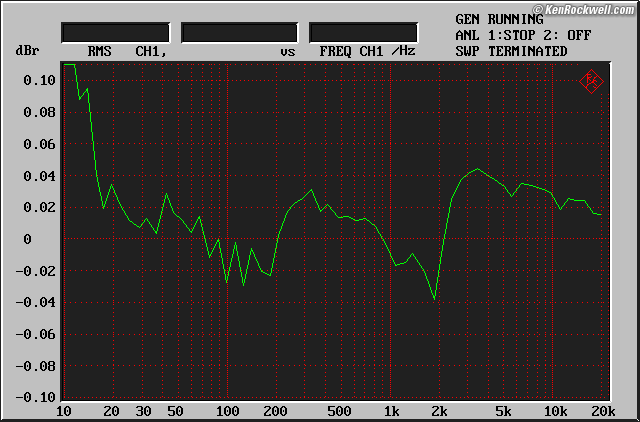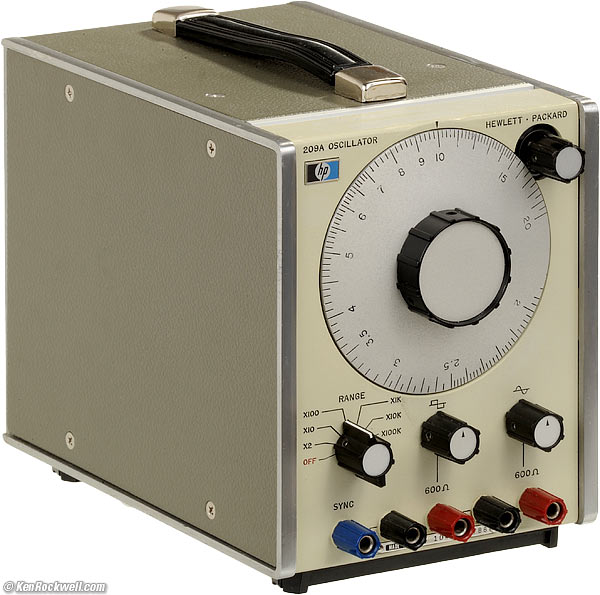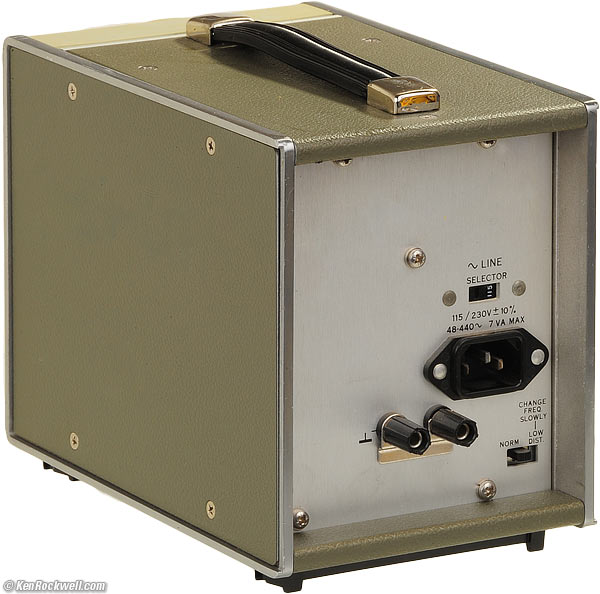Home Donate New Search Gallery Reviews How-To Books Links Workshops About Contact
Hewlett-Packard 209A
4 Hz - 2 MHz Audio Oscillator (1968-)
© 2011 KenRockwell.com. All rights reserved.
Intro Specs Performance Compared Usage Recommendations
HP 209A Oscillator. enlarge. This free website's biggest source of support is when you use these links, especially this link directly to the HP 209A at eBay (see How to Win at eBay) when you get anything, regardless of the country in which you live. Thanks! Ken.
Janaury 2012 All Reviews Audio Reviews
WARNING: This is a professional laboratory instrument. If you lack the appropriate professional qualifications, you probably won't kill yourself working with this, but you just might. This is not a consumer device. Skill level required: Technician.
Introduction top
Intro Specs Performance Compared Usage Recommendations
|
|
The Hewlett-Packard HP 209A is probably the world's most useful and versatile general-purpose audio oscillator. You'd be hard pressed to pay more than $100 for it at eBay (see How to Win at eBay).
The 209A stands out because it's small, light, simple to operate, and most importantly, sweeps directly and precisely across the right ranges for audio with a minimum of band-switching. It draws very little power, and turns on immediately as you'd expect from its all-analog transistorized circuitry.
It can be set instantly and precisely by looking at the great big dial.
The 209A is ideal for generating signals for sweeping loudspeaker systems, listening for buzzes and speaker and room resonances.
Other oscillators cover weird ranges so that one has to switch ranges in weird places, and digital generators can't do real sweeps anyway. Digital generators only approximate sweeps as many steps, while with this oscillator, there are both coarse and fine frequency controls for real time sweeps.
For automated testing, one would want a different generator. This generator is ideal for live hands-on testing. With the HP 209A, it's trivial to test for audible distortion and measure frequency response in just about any system, far easier than with more advanced and complex digital test gear.
It generates sine (0.1% THD) and square waves (50 nS rise/fall time).
The ranges are:
4-40 Hz
20-200 Hz
200-2,000 Hz
2- 20 kHz
20-200 kHz
0.2-2.0 MHz.
For audio, the three 20 Hz - 20 kHz ranges are ideal, while the lowest range covers infrasonics. The higher ranges are best for interfering with AM radio broadcasts.
Output source impedance is 600 Ω, and output open-circuit sine-wave voltages range from 260 mV (-11 dBV) to 11 V RMS (21 dBV), as tested.
Rear, HP 209A Oscillator. enlarge.
As one of America's finest products made at the height of America's greatness (the Apollo age), this device is made extremely well.
The big dial is connected to the tuning capacitor with complex no-backlash gearing.
The power switch is the frequency-range switch.
The screws are made of stainless steel
Oddly, the precisely engraved face is plastic, but the aluminum knob is carefully engraved aluminum.
The limit stops for the front dial aren't the internal tuning capacitor, it's stops on the back of the knob keyed to the front of the instrument.
Specifications top
Intro Specs Performance Compared Usage Recommendations
Output
Sine
10 V RMS max open-circuit.
5 V RMS (40 mW or 16 dBm) into 600 Ω.
Square
20 V p-p max open-circuit.
50 ns rise/fall.
±5% symmetry.
Frequency Accuracy
3% of dial reading.
Distortion
0.1 - 1%, rated.
Power Input
115 or 230 V ±10%, 48-440 Hz.
It's rated to consume less than 7 VA.
I measure 7.7 watts power consumption, and it runs cool.
It consumes 2.5 watts even when off, and a reader cautions that it has no internal fuse and never really turns off, so power supply problem can blow it up.
Size
Including all protrusions, it measures 6-3/4" high, 5-1/8" wide and 8-1/2" deep.
Weight
98.5 ounces (2,790 g or 6 pounds, 2.5 oz.), measured.
Measured Performance top
Intro Specs Performance Compared Usage Recommendations
Frequency Accuracy
Much better than rated, it's well within about ±1%.
Distortion
Distortion doesn't vary with level; the output control is a passive attenuator. I checked, it's the same at every setting.
The "LOW DISTORTION" switch on the back is to reduce distortion below 100 Hz, however one must not move the frequency dial too fast. HP suggests to set frequency, and only then move the switch if you really need it. It has no effect at higher frequencies.
As measured with the 700 kHz measurement bandwidth of a Panasonic VP-7721A Audio Analyzer:
THD + N |
Normal Mode |
Low Distortion Mode |
5 Hz |
0.65% |
0.031% |
10 Hz |
0.43% |
0.27%* |
20 Hz |
0.22% |
0.085% |
50 Hz |
0.11% |
0.077% |
100 Hz |
0.085% |
0.077% |
200 Hz |
0.085% |
0.085% |
500 Hz |
0.04% |
0.041% |
1 kHz |
0.038% |
0.038% |
2 kHz |
0.049% |
(no change) |
5 kHz |
0.04% |
(no change) |
10 kHz |
0.047% |
(no change) |
20 kHz |
0.055% |
(no change) |
50 kHz |
0.048% |
(no change) |
100 kHz |
0.051% |
(no change) |
159.9 kHz |
0.064% |
(no change) |
* Oddly limited by the analyzer, which isn't very happy at 10 Hz.
Flatness
Measured with a Tektronix TX3, it was flat ±0.01 dB from 5 Hz to 20 kHz, the limit of the TX3.
Measured with the Panasonic VP-7721A Audio Analyzer, it or the Panasonic are flat to -1 dB to 800 kHz. I suspect the Panasonic is varying, HP rates this as flat ±0.5 dB to 2 MHz.
Measured with a Rohde & Schwarz UPL, it's as flat as can be, about ±0.03 dB. The +0.1 dB rise at 10 Hz is in the UPL:

HP 209A Frequency Response, 3V RMS, 600 Ω load.
This generator is much flatter than this. This lumpy graph is due to sloppy setting on my part of the analyzer's settling functions as I manually swept the generator through three ranges.
Compared top
Intro Specs Performance Compared Usage Recommendations
The HP 204 series (204A, 204B, 204C, 204D) are similar, but slightly less capable and older than this HP 209A.
The HP 204 lacks the square-wave output and has a slightly narrower frequency range, but the real problem for audio is that its decade ranges start and end on ones, not twos, so you'll never be able to sweep 20-200, 200-2,000 and 2k-20k as you can with the HP 209A. With the 204 series, you'll be sweeping from 10-100, then 100-1,000, then 1k-10k, and then need a fourth range for the 10k-20k range. I don't mind breaking sweeps on the twos, but the frequencies around the ones (100 Hz, 1 kHz and 10 kHz) are critical frequencies through which I need to sweep and not switch.
The 204 is great for general purpose use, but for audio, either some of the original tube-type 200 series or this HP 209A are better as the decades start and end on the twos.
Usage top
Intro Specs Performance Compared Usage Recommendations
Check power voltage setting.
Plug in.
Turn on.
See the HP 209A Operation and Calibration Manual for more.
Recommendations top
Intro Specs Performance Compared Usage Recommendations
This is a marvelous generator for general use, and you'd have a hard time paying more than $100 for it at eBay (see How to Win at eBay). If you get one, using my links when you get anything is what supports this site so I can keep adding to it. Thanks! Ken.
More Information
HP 209A Operation and Calibration Manual.
Help me help you top
I support my growing family through this website, as crazy as it might seem.
The biggest help is when you use any of these links to Adorama, Amazon, eBay, Ritz, Calumet and J&R and when you get anything. It costs you nothing, and is this site's, and thus my family's, biggest source of support. eBay is always a gamble, but all the other places always have the best prices and service, which is why I've used them since before this website existed. I recommend them all personally.
If you find this page as helpful as a book you might have had to buy or a workshop you may have had to take, feel free to help me continue helping everyone.
If you've gotten your gear through one of my links or helped otherwise, you're family. It's great people like you who allow me to keep adding to this site full-time. Thanks!
If you haven't helped yet, please do, and consider helping me with a gift of $5.00.
As this page is copyrighted and formally registered, it is unlawful to make copies, especially in the form of printouts for personal use. If you wish to make a printout for personal use, you are granted one-time permission only if you PayPal me $5.00 per printout or part thereof. Thank you!
Thanks for reading!
Mr. & Mrs. Ken Rockwell, Ryan and Katie.
Home Donate New Search Gallery Reviews How-To Books Links Workshops About Contact





